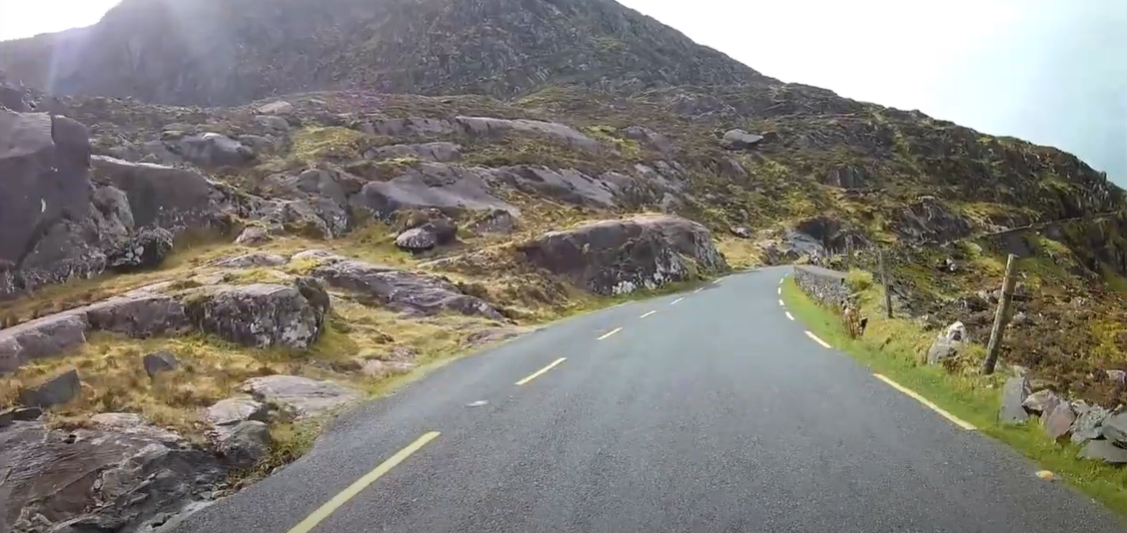
Conor Pass in Ireland is one of the country's most scenic and narrow mountain roads, offering stunning views of the Dingle Peninsula. With a rich history dating back to ancient times, this famous route has also seen a number of accidents and fatalities over the years due to its challenging terrain.
The pass is known for its sharp bends, steep inclines, and unpredictable weather conditions, making it essential for drivers to take caution. This article explores the history of Conor Pass, notable accidents that have occurred, and essential driving tips to ensure a safe and enjoyable journey along this breathtaking route.
During my visit to Conor Pass, I was struck by both its beauty and its treacherous nature. The winding road and sheer drops added an element of excitement, but it was clear that careful driving was a must. As I navigated the sharp curves, the breathtaking views were well worth the effort, but I couldn't help but notice how quickly the weather could change, making it even more important to remain alert on the road.
What Is the Significance of Conor Pass?
The significance of Conor Pass lies in its unique combination of natural beauty, historical importance, and geographical challenges. As one of the highest mountain passes in Ireland, it offers panoramic views of the Dingle Peninsula, connecting Dingle town and Brandon Bay. Notably, the Conor Pass waterfall, nestled near sharp cliff faces, enhances the scenic allure, while the drive along the pass reveals broad sweeping valley spread and glaciated mountain scenery, making it a key highlight in any 10-day Ireland road trip itinerary.
Historically, it has served as a key route for travelers and locals, though its narrow, winding road, populated by oncoming vehicles, and steep cliffs make it a challenging drive. This route passes high corrie lakes, including a glacial corrie lake to the north east, presenting a pristine view typical of Ireland's south coast. The scenic car park, including a small car park, offers a respite for visitors to appreciate the natural vista. Conor Pass also attracts outdoor enthusiasts and tourists for its scenic hiking trails and viewpoints, making it a must-see destination for those exploring Ireland’s rugged landscapes.
What Makes Conor Pass a Popular Tourist Destination?

Conor Pass stands out as a popular tourist destination due to its stunning landscapes and thrilling driving experience. Located on the Dingle Peninsula in County Kerry, Ireland, this mountain pass offers breathtaking views of the surrounding hills and the Atlantic Ocean.
Drivers and cyclists navigate its narrow, winding roads, adding an element of adventure to the journey. The pass also serves as a vantage point for photography enthusiasts, capturing the natural beauty of the Irish coast and countryside. Additionally, its proximity to Dingle, a charming town known for its cultural heritage and gastronomy, makes Conor Pass a must-visit for tourists exploring the region. Conveniently, there is a car park nearby, allowing visitors to safely leave their vehicles as they enjoy the scenic views.
What Are the Dangers of Conor Pass?
The dangers of Conor Pass stem primarily from its narrow and winding roads. Situated in County Kerry, this mountain pass is one of Ireland's highest and offers challenging driving conditions:
-
Sheer Drops: The road features steep precipices without guardrails, posing significant risks of severe accidents if drivers stray too close to the edge.
-
Narrow Pathways: Only suitable for small vehicles, the pass has numerous sharp bends that require careful navigation, especially in poor visibility conditions.
Weather conditions can rapidly change, leading to:
-
Reduced Visibility: Fog and rain are common and can severely limit a driver’s ability to see the road ahead.
-
Slippery Surfaces: Rainfall makes the road slick, increasing the risk of skidding.
Overall, the rugged terrain and unpredictable weather make Conor Pass a beautiful yet potentially hazardous route.
Conor Pass Deaths
Conor Pass has unfortunately seen several accidents and fatalities over the years due to its narrow and winding road, steep cliffs, and unpredictable weather. The challenging terrain, combined with sharp bends and limited visibility in foggy or rainy conditions, increases the risk of accidents.
Some drivers, especially those unfamiliar with the pass, have found the sharp turns difficult to navigate, leading to tragic incidents. Local authorities advise extreme caution when driving on Conor Pass, particularly in adverse weather, to minimize the risk of accidents and ensure a safe journey.
Driving Tips Conor Pass
Driving Tips for Conor Pass in Ireland are essential for navigating this scenic yet challenging route. The pass, known for its narrow and winding roads, demands careful driving to ensure safety. Here, the rugged terrain and sharp bends meet with often unpredictable weather, making it vital to prepare before embarking on this journey.
For those planning to traverse this iconic pass, adhering to specific driving tips can greatly enhance the experience while minimizing risks. In the following sections, we will explore key tips such as using caution on narrow roads, avoiding larger vehicles, and checking weather conditions, among others, to equip drivers with the knowledge needed for a safe trip through Conor Pass.
Use Caution on Narrow Roads
When navigating Conor Pass, prioritize safety due to the road's narrowness. The path, which winds through the mountains of the Dingle Peninsula, requires careful maneuvering and constant attention. Expect sharp bends and blind curves where visibility is limited. Large vehicles are advised against traveling this route, as the pass can become quite constricted in places. Oncoming traffic might appear suddenly, so maintain a low speed and stay alert. Additionally, weather conditions can change rapidly, making the road slippery and reducing visibility further. Always give way to ascending vehicles where possible.
Avoid Larger Vehicles
Conor Pass, known for its narrow and winding roads, is unsuitable for large vehicles. Buses, campervans, and lorries should avoid this route due to tight bends and limited space. Smaller cars enhance safety and maneuverability along the pass. Always check vehicle size recommendations before planning your journey through Conor Pass.
Drive Slowly and Carefully
Driving slowly and carefully is crucial when navigating Conor Pass. The road is narrow and often flanked by steep inclines. Sharp turns and sudden dips require attentive handling and reduced speeds. Visibility can be limited by weather conditions, so proceed with caution. Always allow oncoming traffic ample space. This ensures safety for all travelers on this scenic but challenging route.
Check Weather Conditions
Before navigating Conor Pass, always check the current weather conditions. Sudden fog and rain can reduce visibility dramatically. The route is known for its narrow roads and sharp bends; wet conditions can make these treacherous. Ensure your vehicle's lights and brakes are in optimal condition to handle the unpredictable weather. Avoid the pass in extreme conditions such as ice or heavy fog. Always consult local forecasts and heed any travel advisories before setting out.
Be Mindful of Cyclists and Walkers
Conor Pass, one of Ireland's highest mountain passes, is narrow and winding. Due to its scenic but challenging route, it attracts both cyclists and walkers. Drivers must remain alert and share the road responsibly. Slow down when approaching curves, where visibility is often limited. Always anticipate the presence of pedestrians and cyclists around bends. Give them ample space; overtaking should only be done when it's safe and clear.
Plan Your Route
Before embarking on your journey through Conor Pass, ensure you have a clear map of the route. This mountain pass, located on the Dingle Peninsula in County Kerry, Ireland, features narrow and winding roads that require careful navigation. Familiarize yourself with the key landmarks and potential stopping points. Check weather conditions; fog and rain are common and can significantly reduce visibility. Start early to avoid heavy traffic and to navigate the roads in daylight. Always have a backup plan for alternate routes in case of road closures or severe weather.
Fuel Up Beforehand
Fuel up beforehand when planning to drive Conor Pass in Ireland. Gas stations are scarce on this remote route. Ensure your tank is full before you start the journey. This prevents the risk of running out of fuel amidst the steep and winding roads. Safety and preparedness are crucial when navigating this challenging landscape.
Can You Cycle Through Conor Pass?
Yes, you can cycle through Conor Pass. The route provides a challenging and scenic experience for cyclists. Known for its steep ascents and narrow paths, cycling Conor Pass requires caution, especially during poor weather conditions. The descent offers panoramic views of the Dingle Peninsula, making it a rewarding journey for those prepared for the terrain.
Conor Pass Ireland Map
The Conor Pass Ireland Map highlights the route through one of Ireland's highest mountain passes. The map traces the narrow, twisting road that scales the pass, offering views of the surrounding Dingle Peninsula. Detailed markers indicate scenic viewpoints and cautionary signs for drivers. This essential guide helps navigate the steep inclines and sharp bends characteristic of the area. For safety, the map also points out local advisories and historical sites along the way.
FAQs On Conor Pass Ireland
1. Is Conor Pass in Ireland difficult to drive?
Yes, Conor Pass is challenging to navigate due to its narrow roads and sharp bends. Drivers must be cautious.
2. What should drivers expect when traveling through Conor Pass?
Drivers should expect steep ascents, descents, and tight turns. The pass is also prone to fog and mist, reducing visibility.
3. Has Conor Pass been the site of many accidents?
Conor Pass has witnessed accidents, primarily due to its treacherous driving conditions and poor visibility in bad weather.
4. What are some safety tips for driving on Conor Pass?
Drivers should maintain a low speed, use headlights in poor visibility, and yield to oncoming traffic where the road narrows.
5. What is the historical significance of Conor Pass?
Conor Pass is historically significant as a traditional route used by locals to traverse the Dingle Peninsula, offering ancient and scenic landscapes.
